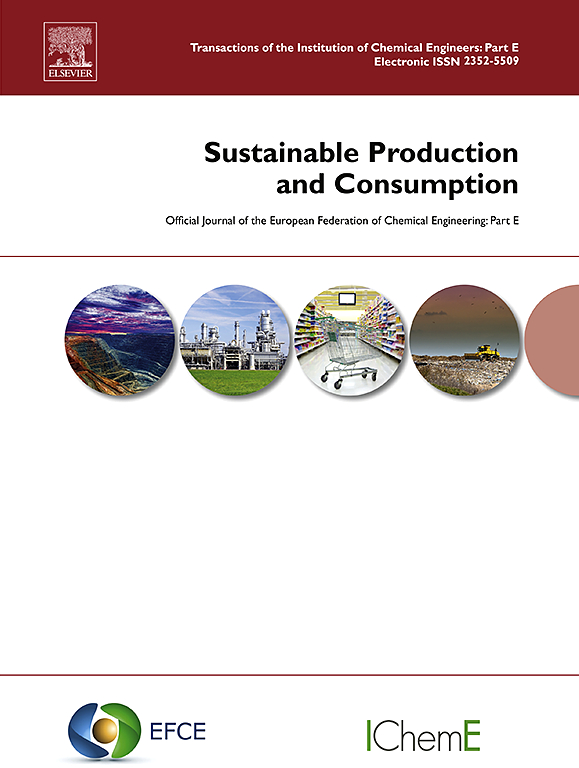供应链循环度综合指数:衡量物料流的闭环性
IF 9.6
1区 环境科学与生态学
Q1 ENVIRONMENTAL STUDIES
引用次数: 0
摘要
从线性经济模式向循环经济模式的转变对可持续工业发展提出了重大挑战,特别是在复杂的多层制造供应链背景下。尽管循环指标有所增加,但许多现有的度量标准存在数据需求过多、协调性差以及缺乏系统级适用性的问题。本文通过提出供应链循环综合指数来解决这些差距,这是一种新的绩效指标,旨在使用基于物料流分析的方法量化物料流的闭环性。该指数将三个关键子指标——材料效率、二次材料使用和回收有效性——汇总为一个综合分数,使用几何平均值来反映供应链参与者之间的比例敏感性和相互依赖性。该指数是通过对59个基本循环指标进行系统的文献回顾而制定的,并通过在塑料和燃气发动机制造业两家不同工业部门运营的制造公司的案例研究进行验证。结果显示了循环性能的变化,揭示了不同情况下不同的循环概况:塑料制造商在所有维度上都具有中等值,实现了0.35的总体循环得分,而燃气发动机公司显示出明显更高的二次材料使用水平(0.56),但受限于低回收效率仅为0.06,导致总体循环得分为0.30。这些结果说明了该指数在确定整个材料循环的特定优势和不足方面的诊断能力。因此,该指数为旨在改善跨供应链边界的材料循环的公司提供了一个可扩展和操作可行的指标,并作为将业务实践与新兴监管和可持续性框架保持一致的战略工具。本文章由计算机程序翻译,如有差异,请以英文原文为准。

Supply chain circularity composite index: Measuring the closed-loopedness of material flows
The transition from linear to circular economic models presents a critical challenge for sustainable industrial development, particularly in the context of complex, multi-tiered manufacturing supply chains. Despite the rise of circularity indicators, many existing metrics suffer from excessive data requirements, poor harmonization, and a lack of system-level applicability. This paper addresses these gaps by proposing the Supply Chain Circularity Composite Index, a novel performance metric designed to quantify the closed-loopedness of material flows using a Material Flow Analysis-based approach. The index aggregates three key sub-indicators - Material Efficiency, Secondary Material Usage, and Effectiveness of Recovery - into a composite score using the geometric mean to reflect proportional sensitivity and interdependency among supply chain actors. The index was developed through a systematic literature review of 59 foundational circularity metrics and validated through case studies in two manufacturing companies operating in distinct industrial sectors, the plastics and the gas engine manufacturing industry. Results demonstrate variation in circularity performance revealing distinct circularity profiles across the cases: The plastics manufacturer, with moderate values across all dimensions, achieved an overall circularity score of 0.35, whereas the gas engine firm showed the significantly higher level of secondary material usage (0.56) but was limited by a low recovery effectiveness of just 0.06, resulting in an overall circularity score of 0.30. These outcomes illustrate the index's diagnostic power to pinpoint specific strengths and deficiencies across the material loop. The index thus provides a scalable and operationally feasible indicator for companies aiming to improve material circularity across supply chain boundaries, and serves as a strategic instrument for aligning business practices with emerging regulatory and sustainability frameworks.
求助全文
通过发布文献求助,成功后即可免费获取论文全文。
去求助
来源期刊

Sustainable Production and Consumption
Environmental Science-Environmental Engineering
CiteScore
17.40
自引率
7.40%
发文量
389
审稿时长
13 days
期刊介绍:
Sustainable production and consumption refers to the production and utilization of goods and services in a way that benefits society, is economically viable, and has minimal environmental impact throughout its entire lifespan. Our journal is dedicated to publishing top-notch interdisciplinary research and practical studies in this emerging field. We take a distinctive approach by examining the interplay between technology, consumption patterns, and policy to identify sustainable solutions for both production and consumption systems.
 求助内容:
求助内容: 应助结果提醒方式:
应助结果提醒方式:


